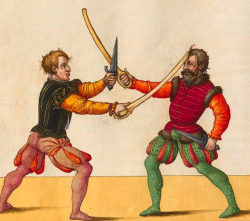 Which
Weapon is Right for You? Which
Weapon is Right for You?
By
John Clements
ARMA Director
The variety of distinct Medieval and Renaissance era weapons is considerable.
Most every student of the craft eventually comes to find one in particular
which they find most appealing or feel they are the most adept with. Virtually
every serious practitioner will in time discover the weapon which is "right"
for them.
The first truth of historical fencing is that there is no "best"
weapon. Every fighting tool is a product of the conditions which prompted
its design and the technology that permitted its development. Every design
is in a sense an answer to a distinct set of martial problems. The second
truth of historical arms is that there are "families" of hand-weapons
for a reason. There are pole arms, there are daggers, there are single-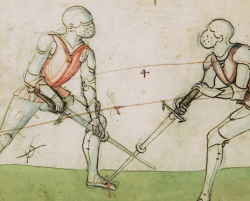 handed
blades and double handed blades, there are axes, and there are clubs and
flails. Every one is a solution to the challenges of close combat, either
general or particular. Each is a product of the age and society that produced
it. But their intended purpose is unmistakeable. They are tools of war,
duel, and self-protection. handed
blades and double handed blades, there are axes, and there are clubs and
flails. Every one is a solution to the challenges of close combat, either
general or particular. Each is a product of the age and society that produced
it. But their intended purpose is unmistakeable. They are tools of war,
duel, and self-protection.
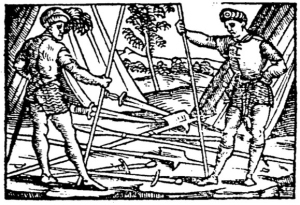 While
every weapon relies on the same core principles of fighting, there are
certainly weapons better suited to one manner of combat than another.
A poleax would be less effective in a pub fight than a cinquedea,
for example, and a rapier not nearly as advantageous in a pike formation
as a katzbalger. A spear isn't as ideal in a back-alley brawl as
a stiletto, for instance, and a francisca throwing axe not the
best on a cavalry charge. While
every weapon relies on the same core principles of fighting, there are
certainly weapons better suited to one manner of combat than another.
A poleax would be less effective in a pub fight than a cinquedea,
for example, and a rapier not nearly as advantageous in a pike formation
as a katzbalger. A spear isn't as ideal in a back-alley brawl as
a stiletto, for instance, and a francisca throwing axe not the
best on a cavalry charge.
There are subtleties to different weapons, such as the difference between
stiffer, tapered, virtually edgeless swords ideal for armored combat compared
to the curved, single-edge cleavers suited for unarmored fighting. Narrower,
tapered warswords unquestionably handle differently than do wider parallel-edge
falchions, just as military cut-and-thrust side-swords perform differently
than do the thin, near edgeless blades of true rapiers. A halberd is not
identical to wielding a spear, and handling a long pike not the same as
a short staff. The only way to learn what you like is to try as many as
possible long enough for you to acquire a feel for their unique characteristics.
Many weapons have intrinsic advantages in reach or speed, but are deficient
in certain situations or against certain arms and armor combinations.
If this weren't so, there wouldn't have been so many different kinds of
weapons used throughout history.
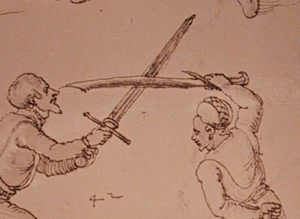 We
might say that in one regard all weapons are "right" for any
and all students, since they all follow a common method while having elements
distinct to their own function and handling. We all develop interests
in fencing and armed fighting for one reason or another and we all have
proficiencies that lend themselves to the different attributes of weapons.
Arguably, different weapons favor particular builds and temperaments.
A flail is not nearly as subtle as a rapier and a two-handed great-sword
less agile than a messer. While one might not choose to ideally match
a short single-handed estoc against a black-bill, it would certainly
be effective in armored combat. A peasant farming scythe or agricultural
sickle adopted for self-defense can be interesting to explore, even if
you find it not as versatile as a sword and buckler. The simple reality
of Renaissance weaponry is that very few if any were conceived to face
off only against another matching model, but instead conceived to deal
with whatever situation a fighting man encountered. The Art of Defence
arose for this very reason. We
might say that in one regard all weapons are "right" for any
and all students, since they all follow a common method while having elements
distinct to their own function and handling. We all develop interests
in fencing and armed fighting for one reason or another and we all have
proficiencies that lend themselves to the different attributes of weapons.
Arguably, different weapons favor particular builds and temperaments.
A flail is not nearly as subtle as a rapier and a two-handed great-sword
less agile than a messer. While one might not choose to ideally match
a short single-handed estoc against a black-bill, it would certainly
be effective in armored combat. A peasant farming scythe or agricultural
sickle adopted for self-defense can be interesting to explore, even if
you find it not as versatile as a sword and buckler. The simple reality
of Renaissance weaponry is that very few if any were conceived to face
off only against another matching model, but instead conceived to deal
with whatever situation a fighting man encountered. The Art of Defence
arose for this very reason.
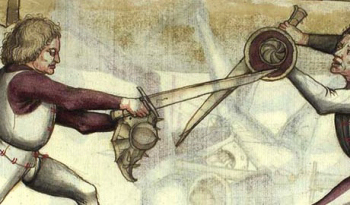 Yet,
given good time with each (and competent instruction), there are noticeable
attributes to different kinds of weapons that every student will easily
find. Some weapons do indeed favor stronger builds, taller statures, faster
frames, and either more aggressive or more cautious personalities. Just
how this is so is open to conjecture and debate. The best thing any fighter
can do is experiment; to explore and learn, by trying as many different
weapons and weapon combinations as possible. Yet,
given good time with each (and competent instruction), there are noticeable
attributes to different kinds of weapons that every student will easily
find. Some weapons do indeed favor stronger builds, taller statures, faster
frames, and either more aggressive or more cautious personalities. Just
how this is so is open to conjecture and debate. The best thing any fighter
can do is experiment; to explore and learn, by trying as many different
weapons and weapon combinations as possible.
While some works of popular fiction might depict an unusual double-axe
wielding hero or some bizarre flail and spiked-buckler combination, the
historical record will better 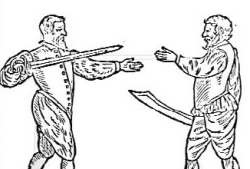 inform
us as to what was actually used and what was proven to work. Variety is
good and it's certainly a virtue to learn as wide a range of weapons as
possible. But if you have a favorite you're prone to practice more. The
key is to find out what you find fun to play with, what moves you enjoy
executing with it, and how adeptly you enjoy handling it. Learn what it
does, how it exercises your muscles when you practice alone, and how it
fits your personal proclivities as a fighter when you exercise and free-play.
You might stop and ask yourself: What do you like about training with
it? What do you find challenging about sparring with it? You may discover
that it's another weapon entirely that meets your interest more than you
expected. inform
us as to what was actually used and what was proven to work. Variety is
good and it's certainly a virtue to learn as wide a range of weapons as
possible. But if you have a favorite you're prone to practice more. The
key is to find out what you find fun to play with, what moves you enjoy
executing with it, and how adeptly you enjoy handling it. Learn what it
does, how it exercises your muscles when you practice alone, and how it
fits your personal proclivities as a fighter when you exercise and free-play.
You might stop and ask yourself: What do you like about training with
it? What do you find challenging about sparring with it? You may discover
that it's another weapon entirely that meets your interest more than you
expected.
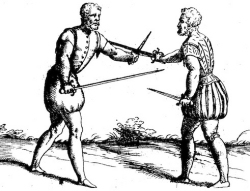 Finding
the weapon best suited to you can however be problematic in several ways.
As mentioned, without a credible program of training you may obtain unreliable
results with a one weapon or another. A faulty mode of practice or weak
method of study will surely produce a flawed appreciation for how the
genuine article ideally works. Similarly, the accuracy and quality of
the training tools or weapon simulators that you rely on will greatly
affect what you can do and what you can learn with it. Poorly made replica
weapons and inferior substitutes with improper performance characteristics
will handle more unrealistically than accurate reproductions. They will
distort techniques and limit the manner and extent by which you can wield
them. They cannot help but produce distortions in the way core principles
are applied and inevitably lead to bad habits. When your knowledge and
experience revolves around training with substitutes that bear little
resemblance to the functionality of the real historical pieces, well then,
your ability will suffer without your even being aware. It's certainly
difficult to evaluate if a certain weapon is right for you if the one
you're using hardly reflects the attributes of the original. Rather than
learning how it was possible to actually use it, you're instead putting
time and effort into learning to use something that performs differently. Finding
the weapon best suited to you can however be problematic in several ways.
As mentioned, without a credible program of training you may obtain unreliable
results with a one weapon or another. A faulty mode of practice or weak
method of study will surely produce a flawed appreciation for how the
genuine article ideally works. Similarly, the accuracy and quality of
the training tools or weapon simulators that you rely on will greatly
affect what you can do and what you can learn with it. Poorly made replica
weapons and inferior substitutes with improper performance characteristics
will handle more unrealistically than accurate reproductions. They will
distort techniques and limit the manner and extent by which you can wield
them. They cannot help but produce distortions in the way core principles
are applied and inevitably lead to bad habits. When your knowledge and
experience revolves around training with substitutes that bear little
resemblance to the functionality of the real historical pieces, well then,
your ability will suffer without your even being aware. It's certainly
difficult to evaluate if a certain weapon is right for you if the one
you're using hardly reflects the attributes of the original. Rather than
learning how it was possible to actually use it, you're instead putting
time and effort into learning to use something that performs differently.

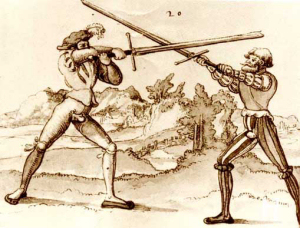 In
my opinion, learning one weapon especially well teaches you to better
apply all the core elements of fighting to any other weapon, but only
if you can apply them well enough to understand how they differ one to
another. I have worked with and taught all manner of students over the
past few decades, some possessing natural aptitude, some possessing natural
hindrances. They have been of different ages, both sexes, and all manner
of body shapes and natural proclivities, advantageous and handicapping.
I try to aid their strengths and minimize their weaknesses, teaching the
core principles and foundational concepts for the single sword as a foundation.
But in time I always note whether I think they would find a particular
weapon more effective than another. I based this on my own assessment
of what I would consider for them to be the most challenging to go up
against. I'll suggest attention on that weapon, see if it interests them,
and if they take to it after some effort. Rarely have I misjudged. In
my opinion, learning one weapon especially well teaches you to better
apply all the core elements of fighting to any other weapon, but only
if you can apply them well enough to understand how they differ one to
another. I have worked with and taught all manner of students over the
past few decades, some possessing natural aptitude, some possessing natural
hindrances. They have been of different ages, both sexes, and all manner
of body shapes and natural proclivities, advantageous and handicapping.
I try to aid their strengths and minimize their weaknesses, teaching the
core principles and foundational concepts for the single sword as a foundation.
But in time I always note whether I think they would find a particular
weapon more effective than another. I based this on my own assessment
of what I would consider for them to be the most challenging to go up
against. I'll suggest attention on that weapon, see if it interests them,
and if they take to it after some effort. Rarely have I misjudged.
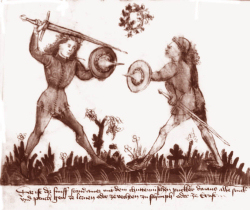 In
my own study and courses of instruction, I follow an interpretation of
the source teachings that emphasizes how the key underlying concepts are
applicable to any weapon. Regardless of the one the student practices
with, they must still apply timing, distance, leverage, covering and binding,
and strike and ward all while in motion. Through this they acquire the
skills to competently handle any weapon they pick up. If you learn short
sword or messer with buckler you apply that to sword and dagger. If you
learn spear you apply it to staff and halberd and other pole arms. If
you learn longsword you apply it to poleax and great-sword. And fighting
with the dagger applies to any short blade, while wrestling skill applies
to everything. By this process the capabilities of different weapon become
known such that each student invariably begins to favor one over others.
Prowess comes through the proficiency achieved by long-term practice with
whatever weapon they work at specializing in. This is the natural way
to find which weapon is right for you. In
my own study and courses of instruction, I follow an interpretation of
the source teachings that emphasizes how the key underlying concepts are
applicable to any weapon. Regardless of the one the student practices
with, they must still apply timing, distance, leverage, covering and binding,
and strike and ward all while in motion. Through this they acquire the
skills to competently handle any weapon they pick up. If you learn short
sword or messer with buckler you apply that to sword and dagger. If you
learn spear you apply it to staff and halberd and other pole arms. If
you learn longsword you apply it to poleax and great-sword. And fighting
with the dagger applies to any short blade, while wrestling skill applies
to everything. By this process the capabilities of different weapon become
known such that each student invariably begins to favor one over others.
Prowess comes through the proficiency achieved by long-term practice with
whatever weapon they work at specializing in. This is the natural way
to find which weapon is right for you.
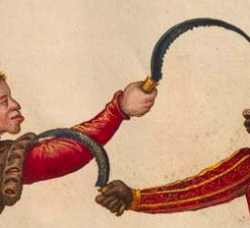 For
myself, my favorite weapon has changed back and forth over the decades.
First it was the sword and dagger, then sword and buckler, then the rapier,
then longsword, then sword and dagger again, and now once more the longsword.
It changed depending on whatever one I was studying the source material
on in any season or of which weapon I had recently gotten a good new model.
Finding "your" weapon is not a matter of over generalization
but specialization. This is necessarily about what weapon you seem "best
with." There will always be some students who will say they have
no "favorite" and practice everything. But given the focus within
the historical self-defense teachings upon the single sword and the emphasis
placed on the dagger and spear (unquestionably the main weapons of our
Western fencing heritage), it's not realistic to claim equal footing for
every weapon. We would not place, for example, the pike or the flail on
the same pedestal as the knightly arming sword or the later dueling rapier.
After all, our forebears evidently didn't. (Not a few students have approached
me about learning a weapon they were fascinated with but for which there
are no historical teachings, such as double-bladed axes or spiked ball
flails.) Sometimes a favored weapon simply comes as a result of the practitioner
developing an interest following the reading of one particular historical
master's writings, thereby (presumably) experiencing theory as hands-on
practicality. For
myself, my favorite weapon has changed back and forth over the decades.
First it was the sword and dagger, then sword and buckler, then the rapier,
then longsword, then sword and dagger again, and now once more the longsword.
It changed depending on whatever one I was studying the source material
on in any season or of which weapon I had recently gotten a good new model.
Finding "your" weapon is not a matter of over generalization
but specialization. This is necessarily about what weapon you seem "best
with." There will always be some students who will say they have
no "favorite" and practice everything. But given the focus within
the historical self-defense teachings upon the single sword and the emphasis
placed on the dagger and spear (unquestionably the main weapons of our
Western fencing heritage), it's not realistic to claim equal footing for
every weapon. We would not place, for example, the pike or the flail on
the same pedestal as the knightly arming sword or the later dueling rapier.
After all, our forebears evidently didn't. (Not a few students have approached
me about learning a weapon they were fascinated with but for which there
are no historical teachings, such as double-bladed axes or spiked ball
flails.) Sometimes a favored weapon simply comes as a result of the practitioner
developing an interest following the reading of one particular historical
master's writings, thereby (presumably) experiencing theory as hands-on
practicality.
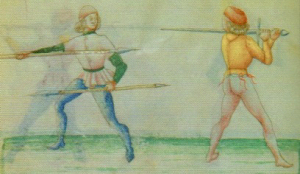 The
martial arts of Renaissance Europe are weapon-centric. Although their
core comes from the unarmed skills of wrestling and grappling, and there
are several source works of unarmed fighting, the largest portion of teachings
are invariably on using weapons. The vast majority of treatises and books
we study are about fencing. That is, they are concerned more often with
swordsmanship as the primary means of self-defense. But, even as its origin
derives from wrestling and every weapon employs (requires) unarmed skills,
the art of the sword lays the foundation for all weapons. Whatever weapon
a student may come to gain a special affinity for, they must learn the
sword. In particular, the double-handed warsword or longsword. It would
certainly make little sense to study Renaissance martial arts but not
learn the sword. (Just which type of sword or swords is the question.) The
martial arts of Renaissance Europe are weapon-centric. Although their
core comes from the unarmed skills of wrestling and grappling, and there
are several source works of unarmed fighting, the largest portion of teachings
are invariably on using weapons. The vast majority of treatises and books
we study are about fencing. That is, they are concerned more often with
swordsmanship as the primary means of self-defense. But, even as its origin
derives from wrestling and every weapon employs (requires) unarmed skills,
the art of the sword lays the foundation for all weapons. Whatever weapon
a student may come to gain a special affinity for, they must learn the
sword. In particular, the double-handed warsword or longsword. It would
certainly make little sense to study Renaissance martial arts but not
learn the sword. (Just which type of sword or swords is the question.)
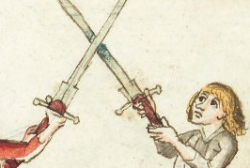 The
longsword teaches the essential cuts, thrusts, and strikes, as well as
easily conveys everything about warding, displacing, binding, trapping,
halfing. It can be used with either one or both hands to act in different
ways like a club, a staff, a spear, or a war-hammer, depending on the
need. It can be paired with shields or a dagger, wielded mounted or foot,
employed armored or unarmored. It simply offers the widest variety of
techniques from the largest library of instructional material. The
longsword teaches the essential cuts, thrusts, and strikes, as well as
easily conveys everything about warding, displacing, binding, trapping,
halfing. It can be used with either one or both hands to act in different
ways like a club, a staff, a spear, or a war-hammer, depending on the
need. It can be paired with shields or a dagger, wielded mounted or foot,
employed armored or unarmored. It simply offers the widest variety of
techniques from the largest library of instructional material. 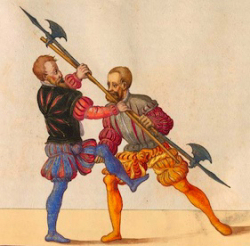 But
even then, it comes in considerable types, varying its form in length,
width, weight, curvature, stiffness, flexibility, resilience, strength,
balance, sharpness, pointedness, hilt composition, and edge configuration.
Its versatility arguably makes it formidable against all other hand-weapons
or combinations. But
even then, it comes in considerable types, varying its form in length,
width, weight, curvature, stiffness, flexibility, resilience, strength,
balance, sharpness, pointedness, hilt composition, and edge configuration.
Its versatility arguably makes it formidable against all other hand-weapons
or combinations.
After exploring many weapons for several years I found the longsword
the most appealing weapon for me. I've come to enjoy working and instruction
with the longsword more than any other weapon even as simultaneously I
study a multitude of them. It continues to surprise me what new aspects
I uncover with the longsword. But I never treat it in isolation from the
others, for every Medieval and Renaissance weapon existed in a world where
it might face any other combination of arms and armor. My introductory
curriculum is based around the longsword not only because of its martial
effectiveness and the ease by which new students can be taught with it,
but because, more so than any other weapon, it is through its study that
the leading 14th and 15th century sources (and even a good portion of
16th century material) conveyed the essential ideas of the entire Art.
The history of the longsword represents the greatest legacy and lore of
our martial heritage. The longsword, directly descended as it was from
earlier single-hand swords, provided a foundation for fencing that only
declined with the introduction of the civilian rapier as armored combat
declined and the widespread adoption of firearms changed the nature of
both warfare and dueling. So, in my experience, the longsword is central
to the historical Art of Defence. But in the end, I appreciate that its
study didn't exist separately from other weapons. Rather, as I often say,
I just really enjoy wielding it well and that makes for right for
me. Which one is right for you?

|

